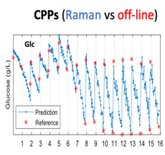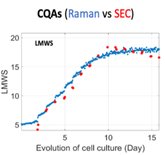Theme 3.2: Qualitative and quantitative monitoring of pharmaceutical and cosmetic active ingredients
Quantitative analysis for cosmetology and pharmaceutical research
Objectives
- Quantify ACI & API according to expected specifications
- Provide an alternative for QC &TDM in clinics
- Improve diagnostics of cancers
- Implement innovative PAT in biopharmaceutical industry
Summary
This theme focuses on the development of modern bioanalytical tools based on molecular optical spectroscopy (Raman, SERS, fluorescence, IR) and separation techniques (UHPLC) in the aim of qualitative and quantitative assessment of complex molecular systems which are relevant in the domains of cosmetology and pharmaceutics.
First of all, it concerns characterization of composition and homogenity of cosmetic and pharmaceutic forms.
For dermo-cosmetic applications, we determine the Active cosmetic ingredient (ACI) distribution within gels and then establish the profiles of its penetration into human skin, in vitro and in vivo.
Confocal spectral imaging (Raman, SERS, fluorescence) algorithms we develop allow to follow quantitatively the active molecules in cancer cells & tissues, within 2D and 3D matrix. In this way, it is possible to monitor the drug delivery and understand its action mechanism.
In clinical context, namely concerning the therapeudic drug monitoring (TDM), we have demonstrated that Quality Control (QC) of clinical solutions can be made both qualitatively and quantitatively, through the walls of the perfusion bag, by means of Raman confocal spectroscopy.
Our expertise in SERS spectroscopy allows us to design and to develop SERS substrates for cancer diagnostics in vitro, through detection of seric biomarkers such as miRNA.
Finally, Raman spectroscopy made through an immersed fiber optic probe can be used in the framework of Process Analytical Technology (PAT), for In-line monitoring of tens of critical parameters of bioprocessing of a recombinant therapeutic antibody by CHO cells cultivated in a bioreactor.
For all these applications, the spectroscopic data treatment is strongly improved thanks to multivariate data analysis (MVDA) and machine learning (ML).
Some recent projects
Keywords
- Active ingredients distribution in cells, tissues
- Cosmetic and Pharmaceutic forms characterization
- Cancer diagnostics
- Therapeudic Drug Monitoring (TDM)
- Process Analytical Technology (PAT)
- In-line bioprocess monitoring
- Multivariate data analysis (MVDA)
- Partial least square regression (PLSR)
- DUPLEX subset selection



